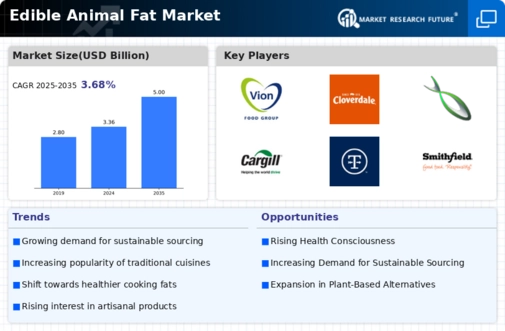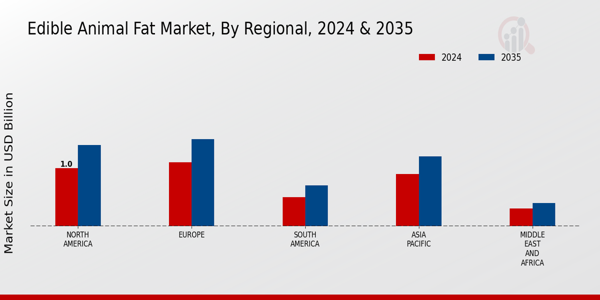Market Growth Projections
The Global Edible Animal Fat Market Industry is poised for growth, with projections indicating a market value of 3.36 USD Billion in 2024 and an anticipated increase to 5 USD Billion by 2035. This upward trajectory highlights the industry's resilience and adaptability in response to evolving consumer preferences and market dynamics. The expected compound annual growth rate of 3.68% from 2025 to 2035 further underscores the potential for expansion. As the market continues to evolve, stakeholders may need to remain vigilant in monitoring trends and consumer behaviors to capitalize on emerging opportunities.
Health and Nutritional Awareness
In recent years, there has been a shift towards health and nutritional awareness among consumers, impacting the Global Edible Animal Fat Market Industry. While some consumers are cautious about saturated fats, others are increasingly recognizing the nutritional benefits of certain animal fats, such as omega-3 fatty acids found in fish oils. This evolving perspective may lead to a more nuanced understanding of animal fats, potentially driving demand for high-quality, sustainably sourced products. As the market adapts to these changing perceptions, it is likely that the industry will innovate to meet consumer expectations, thereby influencing overall market growth.
Rising Demand for Processed Foods
The Global Edible Animal Fat Market Industry is experiencing a notable increase in demand for processed foods, driven by changing consumer lifestyles and preferences. As urbanization continues to rise, more individuals are seeking convenient meal options that often incorporate animal fats for flavor and texture. This trend is reflected in the projected market value of 3.36 USD Billion in 2024, with expectations to reach 5 USD Billion by 2035. The growing inclination towards ready-to-eat meals and snacks, which frequently utilize animal fats, suggests a sustained growth trajectory for the industry, potentially influencing production practices and supply chain dynamics.
Sustainability and Ethical Sourcing
Sustainability and ethical sourcing are becoming increasingly important factors in the Global Edible Animal Fat Market Industry. Consumers are more inclined to purchase products that are sourced responsibly, leading to a demand for animal fats derived from sustainable practices. This shift is prompting producers to adopt more transparent supply chains and engage in ethical farming practices. As the market evolves, companies that prioritize sustainability may gain a competitive edge, potentially influencing consumer purchasing decisions. The industry's commitment to ethical sourcing could also enhance its reputation, fostering trust and loyalty among consumers.
Technological Advancements in Processing
Technological advancements in processing methods are significantly impacting the Global Edible Animal Fat Market Industry. Innovations in extraction and refining processes are improving the quality and shelf life of animal fats, making them more appealing to manufacturers and consumers alike. Enhanced processing techniques can lead to better flavor profiles and nutritional content, which may drive demand in various food applications. As the industry embraces these technological improvements, it is likely to witness a steady growth rate, with a projected CAGR of 3.68% from 2025 to 2035. This growth may reflect the industry's adaptability to changing market needs.
Culinary Trends Favoring Traditional Fats
The Global Edible Animal Fat Market Industry is witnessing a resurgence of interest in traditional cooking methods and ingredients, including animal fats. Culinary trends that emphasize authenticity and flavor are prompting chefs and home cooks alike to incorporate animal fats into their recipes. This trend is particularly evident in regions where traditional cuisines are celebrated, such as in Mediterranean and Asian cooking. As consumers seek to recreate authentic dishes, the demand for animal fats is likely to increase, contributing to the market's growth. The industry's ability to cater to these culinary preferences may play a crucial role in shaping its future.






















Leave a Comment